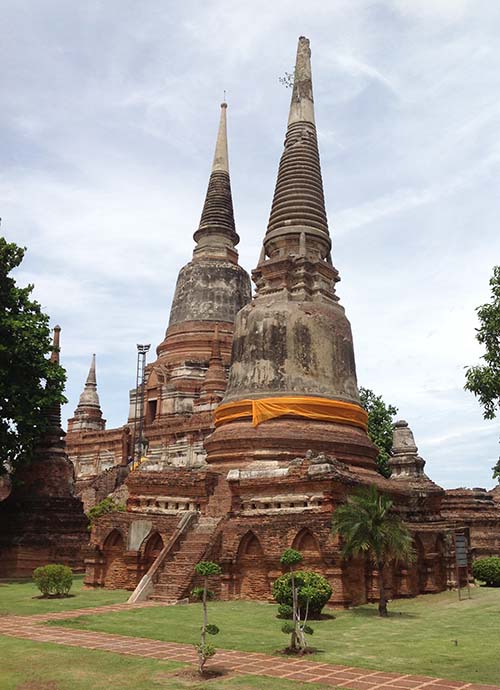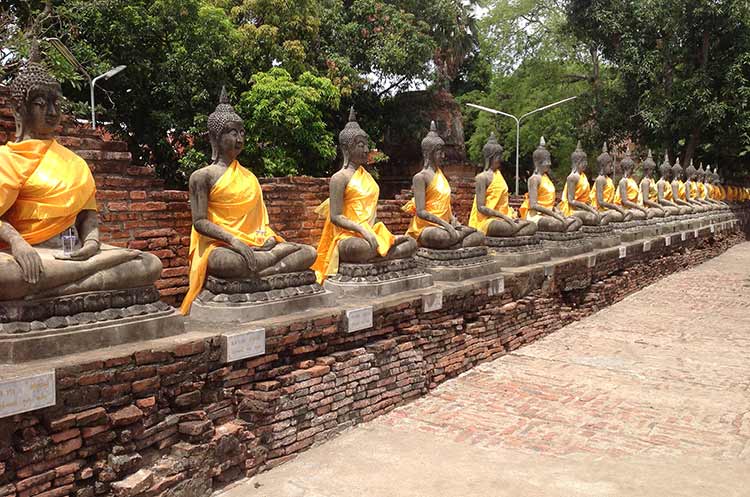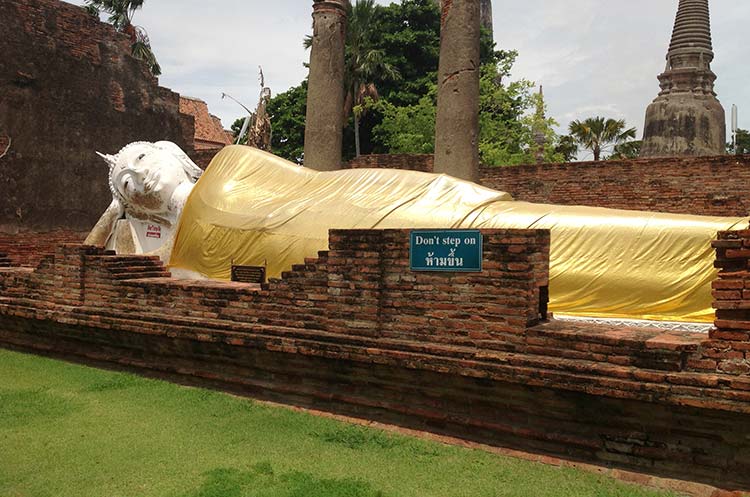
Wat Yai Chai Mongkhon
“The Monastery of Auspicious Victory”
Wat Yai Chai Mongkhon, “the Monastery of Auspicious Victory” is located East of the historical island. Highlight of the monastery is its very large imposing prang dominating the area. Wat Yai Chai Mongkhon is still an active temple; monks live in kuti on the grounds.
Visit this beautiful temple on a private day trip, that also has stops at several other temples and includes a private boat tour around the historical park.
History of Wat Yai Chai Mongkhon
The temple was founded in the second half of the 14th century during the reign of King U Thong, first ruler of Ayutthaya. A chedi and viharn were built, the temple was named Wat Pa Kaeo. Wat Pa Kaeo became an important temple when it was made the seat of the Supreme Patriarch of the forest sect of Buddhism.
The monastery got its present name after construction of the Chedi Chai Mongkhon in the late 16th century.
During the Burmese invasion of 1767 the temple was largely destroyed.
The battle of Nong Sarai
In 1592 the battle of Nong Sarai took place, one of many battles between Ayutthaya and the Burmese. During the battle Ayutthaya King Naresuan moved forward and attacked the Burmese Crown Prince Minchit Sra in one to one combat on war elephants. King Naresuan killed the Burmese Prince with his sword, after which the Burmese army retreated. On return to Ayutthaya the King ordered the Chedi Chai Mongkhon built to commemorate the victory over the Burmese. The battle is depicted on the seal of Suphan Buri province.
Architecture of Wat Yai Chai Mongkhon
The temple’s main structures being the principal chedi, the principal viharn and the ubosot are lined up on an East West axis. Surrounding them stand a number of subsidiary chedis in various styles and state of repair and the kuti, the monks living quarters. In the Northeast corner are the remains of a viharn enshrining a very large Reclining Buddha image.

Chedi Chai Mongkhon, the main prang
At the center of the temple stands a raised platform holding the massive main prang (chedi) and two mondops. At each of the platform’s four corners stands a small version of the prang.
A stairway on the East side leads up to the entrance of the 60 meter tall bell shaped chedi. Visitors can climb up to its interior. Inside a small chamber are several images of the Buddha covered with gold leaf applied by devotees. Visitors can have a view into the excavated chamber where relics were enshrined.
Two mondops, square brick buildings enshrining a large image of the seated Buddha, flank the chedi on the East.
Surrounding gallery
Surrounding the platform is a gallery connecting in the West to the principal viharn. Lining the gallery walls are hundreds of Buddha images draped in yellow cloth seated on pedestals in subduing Mara mudra. The gallery’s wooden roof has long gone.
Main viharn
West of the main prang connecting to the galleries stands the principal viharn, the assembly hall, of which only its base remains. To the back of the hall seated on a pedestal facing West is an image of the Buddha flanked by Sariputta and Moggallana, the Buddha’s closest disciples.
The ordination hall
To the East stands the ubosot, the ordination hall. Since Wat Yai Chai Mongkhon is an active temple the hall is still used by monks and devotees.
The hall’s base and sections of its original walls are still standing while nothing remains of the old roof. New walls have been erected to the inside of the old walls supporting a newly constructed roof. The hall enshrines an image of the Buddha on a pedestal. Sema stones around the ubosot mark the ordination hall’s sacred area.
Reclining Buddha
In the Northeast corner of the grounds are the remains of the Viharn Phra Phuttha Saiyat, the Viharn of the Reclining Buddha image. The hall was constructed during the reign of King Naresuan. A yellow cloth is draped around the huge image that faces East towards the rising sun. The image’s feet are covered with gold leaf applied by devotees. The Buddha image has been restored in 1965.

Other structures
Next to the platform towards the Reclining Buddha viharn stands a very large and well preserved chedi. Around the complex is a large number of subsidiary chedis and the kuti, the monks private living quarters.
Opening hours
Wat Yai Chai Mongkhon opens daily from 8 am until 5 pm.
Entrance fees
Entrance fee is 20 Thai Baht.
- Wat Mahathat
- Wat Chaiwatthanaram
- Wat Phra Si Sanphet
- Wat Ratchaburana
- Wat Phanan Choeng
- Wat Lokaya Sutha
Ayutthaya Historical Park Tours
- From Bangkok
- Private or group tour
- Also visit other highlights like Bang Pa-In Summer Palace